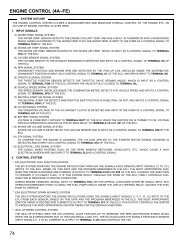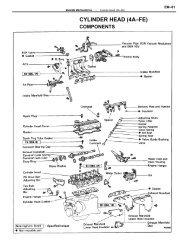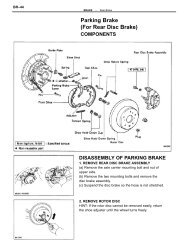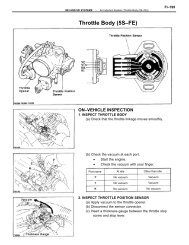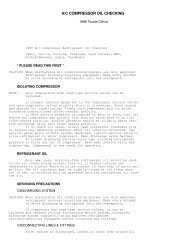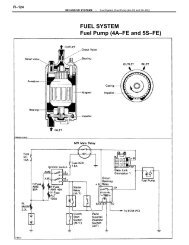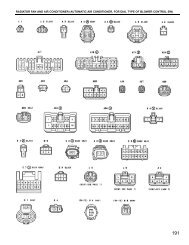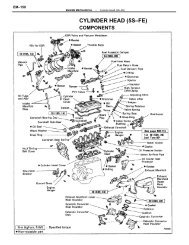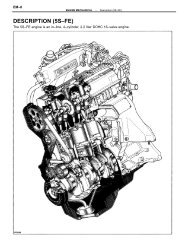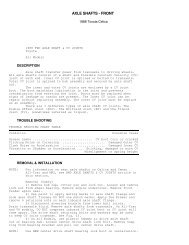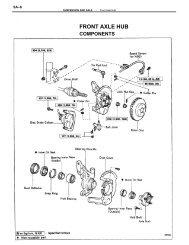turbocharger - CelicaTech
turbocharger - CelicaTech
turbocharger - CelicaTech
Create successful ePaper yourself
Turn your PDF publications into a flip-book with our unique Google optimized e-Paper software.
standard engine. When more power is required, exhaust gases from<br />
exhaust manifold enter the <strong>turbocharger</strong>’s turbine housing and flow<br />
through the turbine blades.<br />
Exhaust flow and turbine speed increase as throttle opens<br />
and RPM increases. The impeller turns with turbine and forces air<br />
into compressor housing and intake manifold. As impeller and turbine<br />
speed increases, boost pressure also increases.<br />
If boost pressure exceeds safe limits, engine damage may<br />
result. The wastegate opens when exhaust pressure exceeds a<br />
predetermined limit and allows exhaust gases to by-pass compressor.<br />
OPERATING PRECAUTIONS<br />
When Starting<br />
After engine has started, allow it to run at idle for several<br />
minutes. If engine has been shut down for a long period, be sure to<br />
run engine at idle until engine oil has circulated throughout engine.<br />
When <strong>turbocharger</strong> is replaced, remove oil pipe by loosening top flare<br />
nut and pour fresh engine oil directly into oil filler port.<br />
During Operation<br />
Monitor oil pressure gauge to confirm that constant oil<br />
pressure is available. If abnormal noise is produced by rotating parts<br />
of <strong>turbocharger</strong>, or unusual vibration is noted, stop operation and<br />
check.<br />
When Stopping<br />
Allow engine to run at idle for several minutes before<br />
stopping engine. If engine is operated at high load, then stopped<br />
abruptly, the engine oil supply is cut off while the <strong>turbocharger</strong> is<br />
still very hot. The <strong>turbocharger</strong> bearings will be overheated and could<br />
be damaged.<br />
TROUBLE SHOOTING<br />
NOTE:<br />
Check the following items. If found defective, replace<br />
<strong>turbocharger</strong> assembly. If related parts are defective,<br />
repair or replace.<br />
VIBRATION OR NOISE<br />
1) Inspect for defective bearings or interference of<br />
rotating parts with related objects. Consider neglect of engine oil<br />
change, sustained use with contamination in oil pipe, a restricted or<br />
broken oil filter. Check for repeated abrupt starts and stops that<br />
could cause bearing failure.<br />
2) If nothing is wrong with lubricating system, an<br />
incorrectly balanced rotating section or bent shaft may be suspected.<br />
This is due to excessive wear of bearings or contamination that have<br />
caused damage to turbine or compressor wheels.<br />
3) If any of these conditions exist, <strong>turbocharger</strong> assembly<br />
must be replaced. Before a new <strong>turbocharger</strong> assembly is installed,<br />
carefully check for contamination or pieces of broken turbine or<br />
compressor wheels which might be left in manifold system.<br />
LOW BOOST PRESSURE<br />
1) Check air cleaner element for contamination or clogging<br />
and clean or replace element as necessary. If turbine or compressor<br />
wheels do not rotate smoothly and lightly when turned by hand,<br />
replace <strong>turbocharger</strong> assembly. Check wastegate valve or relief valve<br />
which might be left opened.



